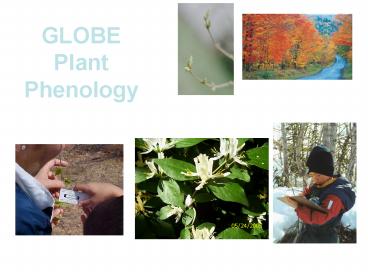GLOBE Plant Phenology - PowerPoint PPT Presentation
1 / 20
Title:
GLOBE Plant Phenology
Description:
Title: Slide 1 Author: Elena Sparrow Last modified by: Jessica Robin Created Date: 7/27/2004 11:31:10 AM Document presentation format: On-screen Show – PowerPoint PPT presentation
Number of Views:63
Avg rating:3.0/5.0
Title: GLOBE Plant Phenology
1
GLOBE Plant Phenology
2
Phenology
- Phenology is the study of living organisms
response to seasonal and climatic changes in
their environment. - Seasonal changes include variations in day length
or duration of sunlight, precipitation, and
temperature.
3
Plant Phenology
- Plant growing season generally corresponds to the
period between green-up and green-down. - Growing season directly related to global carbon
fixation and the amount of CO2 in the atmosphere. - Timing of green-up and green-down is important
for understanding the global water cycle. As
plants photosynthesize, they also transpire water
from the soil into the atmosphere
4
Phenology
- Green-up and green-down data are used to examine
- regional and global vegetation patterns
- year-to-year trends
- vegetation responses to climate change
- wild fire danger
- animal migrations
5
Phenology
- Uses of Phenology Measurements
- Estimates of greenness values from remote sensing
data vary because of problems from atmospheric
properties, sun angle, aging of satellite
detectors. - GLOBE ground-based observations will help
scientists validate estimates of growing seasons.
6
Increase in plant growing season length according
to remotely sensed data
Myneni,R.B. et.al. 1997. Nature, 386, 698-702.
Theres a need for ground observations/data.
7
Plant PhenologyProtocols
- Budburst
- Green-up
- Green-down
8
PhenologyBudburst
- Observe trees, twice weekly, starting at least
two weeks before initial budburst. - Report date of budburst when you see leaves
breaking out of the buds in three different
branches of each tree.
9
PhenologyGreen-up andGreen-down
- Observe buds and report dates of green-up stages
and leaf growth, twice weekly, starting at least
two weeks before initial budburst . - Measure leaf blade length until length stops
increasing. - Observe leaves twice weekly, starting two weeks
before initial green-down - Report dates of green-down color changes until
leaf color change is complete or leaves fall off.
10
(No Transcript)
11
Plant Phenology Green-down
12
(No Transcript)
13
Plant PhenologyLearning Activities
- A First Look at Phenology
- Sneak Preview of Budburst
- A Beginning Look at Photosynthesis
- Investigating Leaf Pigments
- 2 inquiry Learning Activities on our website
- www.uaf.edu/olcg
14
Plant PhenologyData Reporting
- 77 schools in 11 countries
- 18 states in the US
- AK (34) and NY (6 schools)
15
Phenology Green-up Green-down Site Selection
- Select deciduous native trees, shrubs or grasses.
- Choose dominant over-story species
- Avoid sites near buildings or where watering or
fertilization is done - If possible, choose a location close to the
Atmosphere and Soil Moisture Study Sites - Keep the elevation difference less than 100
meters
16
Why do Plant Phenology in schools?
- Supports understanding of big concepts in science
such as systems and cycles - Protocols and L.A. are aligned with science and
math education standards - Easy to fit in school day schedule because of
short time required for measurements/observations - Inexpensive equipment, i.e. ruler, color chart
majority of students are already equipped with
remote sensing equipment of eyes and touch - Offers many opportunities for student science
investigations and cross-curricular integration
17
Phenology Field Campaign
- Research Question
- Can we observe differences in plant phenology
(for same species) along an urban to rural
gradient?
18
Phenology
- Green-Up and Green-Down Site Selection
- Select deciduous trees, shrubs or grasses.
- Choose dominant over-story species - Green-up and
green-down data from satellites are affected
predominantly by these dominant species - If over-story plants are evergreen conifers, use
under-story broadleaf trees or shrubs - Try to use the same plants for green-up and
green-down
19
Phenology
- Green-Up and Green-Down Site Selection
- If possible, choose a location close to the
Atmosphere and Soil Moisture Study Sites - Local topography can cause weather to vary even
within short distances - Keep the horizontal distance between Phenology
and Atmosphere and Soil Moisture Study Sites less
than 2 kilometers - Keep the elevation difference less than 100 meters
20
Some Deciduous species in Alaska
- Quaking aspen Paper birch
Black cottonwood - Populus tremuloides Betula papyrifera
Populus trichocarpa































